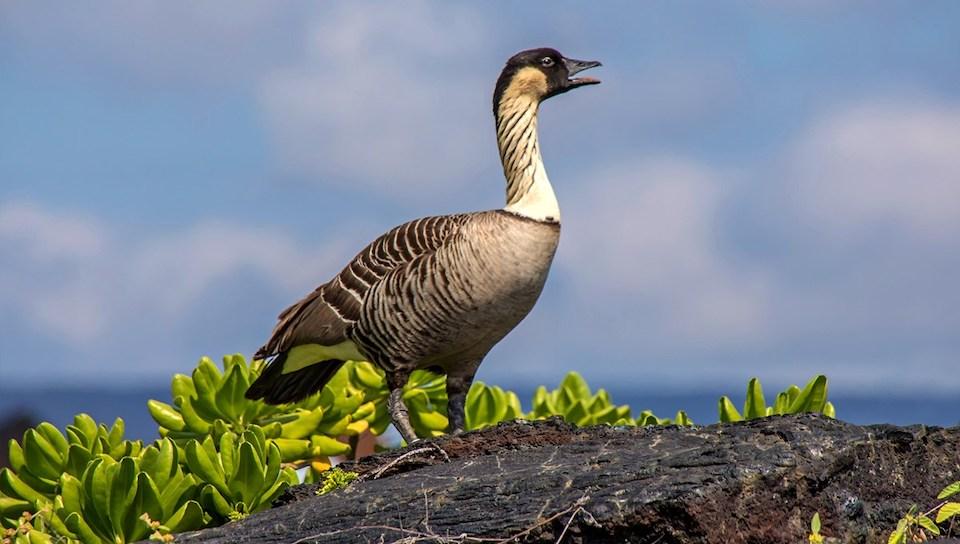
Interior Secretary David Bernhardt traveled to Hawai'i on Sunday to announce the downlisting of the nēnē under the Endangered Species Act/Hawaii Pacific Parks
Vehicles, feral cats, and habitat shrinkage all have conspired against the nēnē, the Hawaiian goose, but conservation efforts nevertheless have been making positve strides in population growth for Hawai'i's state bird. So much so, in fact, that Interior Secretary David Bernhardt traveled to Hawai'i on Sunday to announce that the nēnē can safely be "downlisted" to threatened from endangered under the Endangered Species Act.
For six decades conservation efforts involving state, federal, local, and non-governmental organizations have been focused on boosting the nēnē's population. There has been a captive breeding program, habitat restoration, and on-the-ground management strategies employed to move the goose towards recovery.
"In the proposed rule for the downlisting last year, the U.S. Fish & Wildlife Service referenced recent population assessments that estimated the nene population at around 2,800 birds and increasing, with over 1,000 on Hawai'i Island (the Big Island)," said Dr. Rachel S. Sprague, the president of the Conservation Council for Hawai'i and a member of the National Wildlife Federation's board of directors.
"This is a pretty fantastic increase from the low of 30 individuals in the wild in 1960!," she added in an email to the Traveler. "I think from the perspective of most wildlife biologists and conservation managers in Hawai'i, the rebounding of the nēnē population is a true success story for the Endangered Species Act. That nēnē are the first endemic Hawaiian species to meet the criteria for downlisting from endangered to threatened is a testament to the hard work of all the agencies, landowners and other organizations who partnered to give nene the protection and assistance they needed so that they could do the hard work of raising goslings and repopulating their species.
"I feel that downlisting to threatened is the appropriate next step now that nēnē are no longer in imminent danger of extinction - threats to the species do still exist, so nēnē will continue to receive federal and state protection as they continue their recovery, while allowing more flexibility for landowners to take action to improve nēnē habitat without some of the restrictions that come with endangered species presence," added Dr. Sprague. "Ultimately, Hawai'i has an overwhelming number of species on the brink of extinction. So acknowledging the success of the nēnē conservation efforts and taking this step will now allow conservation experts and regulators to focus resources on species whose populations are in steep decline and in great need of our help."
At the Center for Biological Diversity, a group that often has been in the position of suing the Fish and Wildlife Service to list species under the ESA so they might recover, staff also supported the downlisting.
"Nēnē have made great gains on the island of Kauai and are making slow, but steady, recovery on other islands," said Maxx Phillips, Esq., the Hawaii director and staff attorney for the center.
According to the center, the estimated 2018 nēnē population stood at 3,159. This year's estimate was not yet available, said Phillips.

The nēnē population has made dramatic climbs since the 1960s, when it was thought just 30 of the birds remained in the wild/NPS, Janet Wei
According to the staff at Hawai'i Volcanoes National Park, "...the Island's most noticeable large native animal is the nēnē or Hawaiian goose. Honored as the State Bird, the endangered nene symbolizes the precarious existence of Hawai‘i's native birdlife. At least nine species of geese evolved in the Islands, probably from ancestors much like the Canada goose. Eight of these species were flightless and probably grazed on the plants of the ancient Hawaiian landscape. Extinction of these flightless geese resulted from hunting by Polynesians and land use changes in Hawai`i's lowlands. ...Though it is a strong and frequent flyer, its short wings, long legs and reduced webbing between its toes indicate that it often walks and seldom swims."
The Park Service estimates that when Captain Cook arrived in Hawai'i in 1778 that there might have been 25,000 nēnē on the island.
"By the mid 1940s only 50 birds remained. Populations were drastically reduced by introduced predators such as mongooses, cats and dogs; by foraging animals such as cattle, goats and pigs; by hunters; by introduced plants which compete with native food and cover plants; and by loss of lowland habitat," the park's website notes.
Captive breeding programs at the park started in the 1970s, but the challenges were tough to overcome.
"Mongooses and feral cats kill adults and goslings. Automobiles hit and kill nene along roadways," the park said. "Nēnē that are attracted to the grassy fairways of golf courses suffer injury or death by errant golf balls. In upland habitats, nutrition is usually not adequate for gosling growth requirements."
Bernhardt was to make the downlisting announcement Sunday afternoon at the Honouliuli Unit of the Pearl Harbor National Wildlife Refuge Ewa Beach.




 Support Essential Coverage of Essential Places
Support Essential Coverage of Essential Places







Comments
I would also like to bring your attention to this public service announcement that was made early in 2016 to bring pop culture into the mix in recognizing the plight of the Ne Ne...http://59in59.com/the-blog/2016/2/18/the-endangered-ne-ne